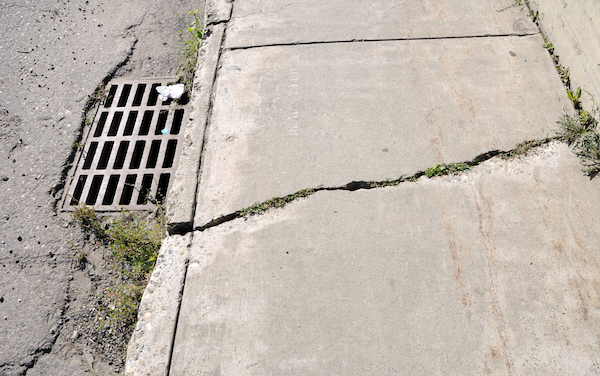Does your concrete driveway, sidewalk, walkway, pool deck or patio have problem areas? Is sunken concrete causing uneven surfaces and tripping hazards? Instances where outdoor concrete has already begun to sink is not uncommon in our area and is often caused by shifting, erosion or a weak soil base. Cracked concrete can bring many problems if not fixed immediately.
Whether at your home or place of business, E & K Contractors wants you to be informed about five hazards that can accompany cracked concrete and why you should repair it.
Damage to cars
It may not be easy to tell how deep a concrete crack, is particularly when there is water held in it. Motorists may not be able to slow down if they are unable to determine the depth of the cracked concrete. A crack in the concrete that has become deep may damage a vehicle, and even pose a danger to others.
Tripping hazards
When there is a crack in a sidewalk, on steps, driveway or parking lot, there is a risk of someone tripping. This could be a cause of a lawsuit, which is something you want to avoid.
Frost Heaves
Apart from growing and becoming wide, a crack in the concrete can also attract water in between them. The water will freeze as the temperature goes down, and the ice will make the crack expand more. Since the ice in the concrete is always slippery, it can cause a pedestrian to slip and fall. It could also cause a motorist to lose control in a parking lot.
Mold exposure
Molds usually tend to grow in the cracks of concrete when water settles in them. This is a typical case when the cracks in the concrete are in places like a basement garage, warehouse, or any other hidden and dark place. Mold can cause serious health complications to the occupants. It is therefore very imperative to clear the cracked concrete mess before it creates other serious hazards.
Cracks will cause more damage
When cracks are not repaired, they will grow from a small crack to become a larger one. This might be costly to repair as opposed to fixing it when it is first noticed.
Why does concrete sink? It’s very heavy, that’s why. However, there are two main causes to sinking outdoor concrete. One is soil shrinkage, and the other is settling and washout of soils.
Soil shrinkage, compacting and settling is at the top. Different types of soil have different load bearing capacities. When a soil’s load-bearing capacity is exceeded, the soil will compact and settle. It’s also possible for the soil beneath a slab to settle and compact of its own accord. Soil that contains large amounts of clay and/or silt will shrink substantially when it gets dry.
As the soil compacts underneath a concrete slab, the unsupported slab will sink as well, usually cracking in one or more spots.
Washout of soils or erosion refers to the soil underneath the driveway, patio, or concrete steps that may not necessarily remain there to provide adequate support for the concrete element.
As water moves underneath your concrete slabs, it can wash away the soil that’s supporting the weight of the concrete. As this happens, it creates a void, or empty space, underneath. Over time, with nothing to support it, your concrete slab can begin to sink or cave in. If you are facing any issues related to drainage in Toledo, consider professional Toledo drain cleaning services to ensure the proper functioning of your drainage system and prevent potential problems. For comprehensive solutions, look into sewer repair company Toledo to maintain the integrity of your drainage infrastructure.
You should repair all problems caused by cracked concretes before they become major hazards. At E & K Contractors, we can easily assess the damage, and help you decide the best way to fix the situation. Additionally, if you are in Toledo and need assistance with asphalt paving or maintenance, consider reaching out to a reputable asphalt company for your needs.

